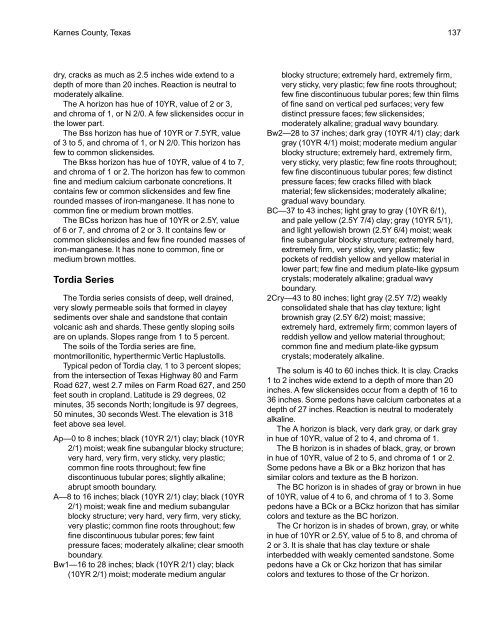Soil Survey of Karnes County, Texas - Soil Data Mart - US ...
Soil Survey of Karnes County, Texas - Soil Data Mart - US ...
Soil Survey of Karnes County, Texas - Soil Data Mart - US ...
Create successful ePaper yourself
Turn your PDF publications into a flip-book with our unique Google optimized e-Paper software.
<strong>Karnes</strong> <strong>County</strong>, <strong>Texas</strong> 137<br />
dry, cracks as much as 2.5 inches wide extend to a<br />
depth <strong>of</strong> more than 20 inches. Reaction is neutral to<br />
moderately alkaline.<br />
The A horizon has hue <strong>of</strong> 10YR, value <strong>of</strong> 2 or 3,<br />
and chroma <strong>of</strong> 1, or N 2/0. A few slickensides occur in<br />
the lower part.<br />
The Bss horizon has hue <strong>of</strong> 10YR or 7.5YR, value<br />
<strong>of</strong> 3 to 5, and chroma <strong>of</strong> 1, or N 2/0. This horizon has<br />
few to common slickensides.<br />
The Bkss horizon has hue <strong>of</strong> 10YR, value <strong>of</strong> 4 to 7,<br />
and chroma <strong>of</strong> 1 or 2. The horizon has few to common<br />
fine and medium calcium carbonate concretions. It<br />
contains few or common slickensides and few fine<br />
rounded masses <strong>of</strong> iron-manganese. It has none to<br />
common fine or medium brown mottles.<br />
The BCss horizon has hue <strong>of</strong> 10YR or 2.5Y, value<br />
<strong>of</strong> 6 or 7, and chroma <strong>of</strong> 2 or 3. It contains few or<br />
common slickensides and few fine rounded masses <strong>of</strong><br />
iron-manganese. It has none to common, fine or<br />
medium brown mottles.<br />
Tordia Series<br />
The Tordia series consists <strong>of</strong> deep, well drained,<br />
very slowly permeable soils that formed in clayey<br />
sediments over shale and sandstone that contain<br />
volcanic ash and shards. These gently sloping soils<br />
are on uplands. Slopes range from 1 to 5 percent.<br />
The soils <strong>of</strong> the Tordia series are fine,<br />
montmorillonitic, hyperthermic Vertic Haplustolls.<br />
Typical pedon <strong>of</strong> Tordia clay, 1 to 3 percent slopes;<br />
from the intersection <strong>of</strong> <strong>Texas</strong> Highway 80 and Farm<br />
Road 627, west 2.7 miles on Farm Road 627, and 250<br />
feet south in cropland. Latitude is 29 degrees, 02<br />
minutes, 35 seconds North; longitude is 97 degrees,<br />
50 minutes, 30 seconds West. The elevation is 318<br />
feet above sea level.<br />
Ap—0 to 8 inches; black (10YR 2/1) clay; black (10YR<br />
2/1) moist; weak fine subangular blocky structure;<br />
very hard, very firm, very sticky, very plastic;<br />
common fine roots throughout; few fine<br />
discontinuous tubular pores; slightly alkaline;<br />
abrupt smooth boundary.<br />
A—8 to 16 inches; black (10YR 2/1) clay; black (10YR<br />
2/1) moist; weak fine and medium subangular<br />
blocky structure; very hard, very firm, very sticky,<br />
very plastic; common fine roots throughout; few<br />
fine discontinuous tubular pores; few faint<br />
pressure faces; moderately alkaline; clear smooth<br />
boundary.<br />
Bw1—16 to 28 inches; black (10YR 2/1) clay; black<br />
(10YR 2/1) moist; moderate medium angular<br />
blocky structure; extremely hard, extremely firm,<br />
very sticky, very plastic; few fine roots throughout;<br />
few fine discontinuous tubular pores; few thin films<br />
<strong>of</strong> fine sand on vertical ped surfaces; very few<br />
distinct pressure faces; few slickensides;<br />
moderately alkaline; gradual wavy boundary.<br />
Bw2—28 to 37 inches; dark gray (10YR 4/1) clay; dark<br />
gray (10YR 4/1) moist; moderate medium angular<br />
blocky structure; extremely hard, extremely firm,<br />
very sticky, very plastic; few fine roots throughout;<br />
few fine discontinuous tubular pores; few distinct<br />
pressure faces; few cracks filled with black<br />
material; few slickensides; moderately alkaline;<br />
gradual wavy boundary.<br />
BC—37 to 43 inches; light gray to gray (10YR 6/1),<br />
and pale yellow (2.5Y 7/4) clay; gray (10YR 5/1),<br />
and light yellowish brown (2.5Y 6/4) moist; weak<br />
fine subangular blocky structure; extremely hard,<br />
extremely firm, very sticky, very plastic; few<br />
pockets <strong>of</strong> reddish yellow and yellow material in<br />
lower part; few fine and medium plate-like gypsum<br />
crystals; moderately alkaline; gradual wavy<br />
boundary.<br />
2Cry—43 to 80 inches; light gray (2.5Y 7/2) weakly<br />
consolidated shale that has clay texture; light<br />
brownish gray (2.5Y 6/2) moist; massive;<br />
extremely hard, extremely firm; common layers <strong>of</strong><br />
reddish yellow and yellow material throughout;<br />
common fine and medium plate-like gypsum<br />
crystals; moderately alkaline.<br />
The solum is 40 to 60 inches thick. It is clay. Cracks<br />
1 to 2 inches wide extend to a depth <strong>of</strong> more than 20<br />
inches. A few slickensides occur from a depth <strong>of</strong> 16 to<br />
36 inches. Some pedons have calcium carbonates at a<br />
depth <strong>of</strong> 27 inches. Reaction is neutral to moderately<br />
alkaline.<br />
The A horizon is black, very dark gray, or dark gray<br />
in hue <strong>of</strong> 10YR, value <strong>of</strong> 2 to 4, and chroma <strong>of</strong> 1.<br />
The B horizon is in shades <strong>of</strong> black, gray, or brown<br />
in hue <strong>of</strong> 10YR, value <strong>of</strong> 2 to 5, and chroma <strong>of</strong> 1 or 2.<br />
Some pedons have a Bk or a Bkz horizon that has<br />
similar colors and texture as the B horizon.<br />
The BC horizon is in shades <strong>of</strong> gray or brown in hue<br />
<strong>of</strong> 10YR, value <strong>of</strong> 4 to 6, and chroma <strong>of</strong> 1 to 3. Some<br />
pedons have a BCk or a BCkz horizon that has similar<br />
colors and texture as the BC horizon.<br />
The Cr horizon is in shades <strong>of</strong> brown, gray, or white<br />
in hue <strong>of</strong> 10YR or 2.5Y, value <strong>of</strong> 5 to 8, and chroma <strong>of</strong><br />
2 or 3. It is shale that has clay texture or shale<br />
interbedded with weakly cemented sandstone. Some<br />
pedons have a Ck or Ckz horizon that has similar<br />
colors and textures to those <strong>of</strong> the Cr horizon.
















